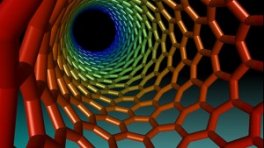 NANOTECHNOLOGY IS HERE…
NANOTECHNOLOGY IS HERE…
Nanotechnology will have profound effects on the way we live. Already, developments are underway for newfound uses. For the architecture profession, nanotechnology will greatly impact construction materials and their properties. Materials will behave in many different ways as we are able to more precisely control their properties at the nano-scale.
WHY CARBON NANOTUBES?
Carbon nanotubes are a great example of how useful materials are being developed. This material is said to be one hundred times stronger than steel because of its “molecular perfection” as explained in the paper Year 2050: Cities in the Age of Nanotechnology by Peter Yeadon. In addition, because carbon atoms can bond with other matter; such material can be an “insulator, semi-conductor or conductor of electricity”. As a result, carbon nanotubes will have significant influence on the architecture industry as such materials can act as “a switchable conduit, a light source, a generator of energy and even a conveyor of matter”. (1)
IMPACTING BOTH DESIGN & CONSTRUCTION
As materials gain such transient features, architectural design and construction will evolve. By transforming the essential properties of matter, nanotechnology will be able to change the way we build. For instance, structures will be constructed from the bottom-up because materials like carbon nanotubes can self-assemble. (1)
 Nanotechnology will profoundly affect the industry of architecture at all scales; and, interior design, building design and city design will all benefit. Architecture will have the ability to function at more optimum levels – revolutionizing the way inhabitants live.
Nanotechnology will profoundly affect the industry of architecture at all scales; and, interior design, building design and city design will all benefit. Architecture will have the ability to function at more optimum levels – revolutionizing the way inhabitants live.
NANO-ARCHITECTURE UNLEASHED
Nanotechnology: Molecular Speculations on Global Abundance is a great book that explains how nanotechnology will impact environments. For example, nanotechnology will give architecture superior interactive functions — allowing occupants to better “communicate” with their surroundings. Windows and walls with variable transparency and mood/context sensitive clothing are just a few ways this will become possible.(2)
As new materials and construction methods emerge, “nano-architecture” will definitely unleash the designer’s imagination. For this reason, Nanotechnology: Molecular Speculations on Global Abundance is worth reading.
Here is the link: Nanotechnology: Molecular Speculations on Global Abundance
(1) Yeadon, Peter. Year 2050: Cities in the Age of Nanotechnology
(2) Crandall, BC. Nanotechnology: Molecular Speculations on Global Abundance. MIT Press. 2000.
Join My Newsletter and Get a Free Copy of my Book
Sign up for the FREE Sensing Architecture Newsletter to achieve breakthrough insights that will expand the way you think about architectural design. This is a great way to set your work apart from the rest. Plus, get free immediate access to Bringing Architecture to the Next Level, where you will learn how to shift your mindset to reach breakthrough ideas, meet and predict occupant need using sensory design, leverage your design process to get more with less, rethink technology to unleash your innovative edge, and so much more.









